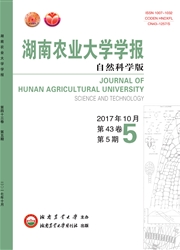

 中文摘要:
中文摘要:
以四川省15个核桃产区411份优树为研究对象,通过对主要性状指标的变异分析、聚类分析和主成分分析,初步探讨四川核桃的表型多样性,结果表明:①果枝率、坚果外观、缝合线、取仁难易和壳厚等主要经济性状指标的变异系数相对较高,分别为53.2%、34.4%、37.4%、25.7%和23.4%,品种选育中宜将果枝率、缝合线、坚果外观、取仁难易及坚果壳厚作为主要参考指标;②在15个核桃产区中,石棉产区各性状的变异程度总体最大,遗传多样性最丰富,综合表现以巴塘产区的最好;③聚类分析结果表明,当遗传距离为25时,四川15个核桃产区可聚为2类,第1类分布于甘孜州和阿坝州,第Ⅱ类分布于凉山州、绵竹和石棉。四川核桃表型特征与气候条件关系密切,果枝率可作为核桃区划的重要依据。
 英文摘要:
英文摘要:
Phenotypic diversity of walnut germplasm resources were investigated from main characters through variation analysis, clustering analysis and principal component analysis based on 411 superior trees from 15 cities/counties in Sichuan. The results were gotten as follows: ① variation coefficients of many economic indicators, such as fruit branches percentage, nut appearance, suture line, difficulty of taking kernel out and shell thickness were in a relative high level, they were 53.2%, 34.4%, 37.4%, 25.7% and 23.4% respectively. Consequently, the four indicators could be considered as reference guides in walnut variety breeding. ② the variation extent of all walnut characters was the greatest in Shimian area among all 15 walnut growing areas, where the genetic diversity showed great abundance. In general, the walnut from Batang area was ranked first in the 15 walnut areas; ③ the result from cluster analysis showed that the 15 walnut areas could be clustered into 2 classes when the distance was 25, i.e., the first class was distributed in Maoxian, Batang, Xiangcheng, Deronga, Jiuzhaigou, Wenchuan, Xiaojin, Songpan, Jiulong and Maerkang, and the second class was distributed in Meigu, Muli, Dechang, Mianzhu and Shimian. The result showed that the phenotypic characteristics of nuts had close relation with climatic condition, and fruit branches percentage could be taken as an important indicator for walnut zoning.
 同期刊论文项目
同期刊论文项目
 同项目期刊论文
同项目期刊论文
 期刊信息
期刊信息
